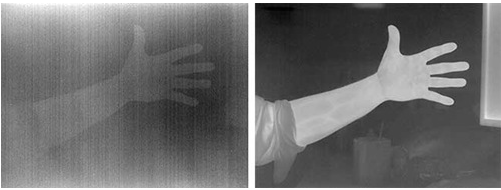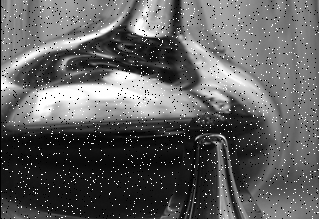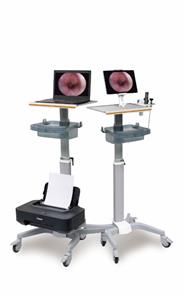Medical Camera Image Noise
Medical Camera Image Noise

Image noise is random variation of brightness or color information in images, and is usually an aspect of electronic noise. It can be produced by the image sensor and circuitry of a scanner or digital camera. Image noise can also originate in film grain and in the unavoidable shot noise of an ideal photon detector. Image noise is an undesirable by-product of image capture that obscures the desired information.
The original meaning of "noise" was "unwanted signal"; unwanted electrical fluctuations in signals received by AM radios caused audible acoustic noise ("static"). By analogy, unwanted electrical fluctuations are also called "noise".
Image noise can range from almost imperceptible specks on a digital photograph taken in good light, to optical and radioastronomical images that are almost entirely noise, from which a small amount of information can be derived by sophisticated processing. Such a noise level would be unacceptable in a photograph since it would be impossible even to determine the subject.
Noise Types
1.Gaussian noise
Principal sources of Gaussian noise in digital images arise during acquisition. The sensor has inherent noise due to the level of illumination and its own temperature, and the electronic circuits connected to the sensor inject their own share of electronic circuit noise.

A typical model of image noise is Gaussian, additive, independent at each pixel, and independent of the signal intensity, caused primarily by Johnson–Nyquist noise (thermal noise), including that which comes from the reset noise of capacitors ("kTC noise"). Amplifier noise is a major part of the "read noise" of an image sensor, that is, of the constant noise level in dark areas of the image.[5] In color cameras where more amplification is used in the blue color channel than in the green or red channel, there can be more noise in the blue channel.[6] At higher exposures, however, image sensor noise is dominated by shot noise, which is not Gaussian and not independent of signal intensity. Also, there are many Gaussian denoising algorithms.
2.Salt-and-pepper noise
Image with salt and pepper noise
Fat-tail distributed or "impulsive" noise is sometimes called salt-and-pepper noise or spike noise. An image containing salt-and-pepper noise will have dark pixels in bright regions and bright pixels in dark regions.[9] This type of noise can be caused by analog-to-digital converter errors, bit errors in transmission, etc.[10][11] It can be mostly eliminated by using dark frame subtraction, median filtering, combined median and mean filtering and interpolating around dark/bright pixels.
Dead pixels in an LCD monitor produce a similar, but non-random, display.

3.Shot noise
The dominant noise in the brighter parts of an image from an image sensor is typically that caused by statistical quantum fluctuations, that is, variation in the number of photons sensed at a given exposure level. This noise is known as photon shot noise.[6] Shot noise has a root-mean-square value proportional to the square root of the image intensity, and the noises at different pixels are independent of one another. Shot noise follows a Poisson distribution, which except at very high intensity levels approximates a Gaussian distribution.
In addition to photon shot noise, there can be additional shot noise from the dark leakage current in the image sensor; this noise is sometimes known as "dark shot noise"[6] or "dark-current shot noise". Dark current is greatest at "hot pixels" within the image sensor. The variable dark charge of normal and hot pixels can be subtracted off (using "dark frame subtraction"), leaving only the shot noise, or random component, of the leakage. If dark-frame subtraction is not done, or if the exposure time is long enough that the hot pixel charge exceeds the linear charge capacity, the noise will be more than just shot noise, and hot pixels appear as salt-and-pepper noise.

4.Quantization noise (uniform noise)
The noise caused by quantizing the pixels of a sensed image to a number of discrete levels is known as quantization noise. It has an approximately uniform distribution. Though it can be signal dependent, it will be signal independent if other noise sources are big enough to cause dithering, or if dithering is explicitly applied.
5.Film grain
The grain of photographic film is a signal-dependent noise, with similar statistical distribution to shot noise. If film grains are uniformly distributed (equal number per area), and if each grain has an equal and independent probability of developing to a dark silver grain after absorbing photons, then the number of such dark grains in an area will be random with a binomial distribution. In areas where the probability is low, this distribution will be close to the classic Poisson distribution of shot noise. A simple Gaussian distribution is often used as an adequately accurate model.
Film grain is usually regarded as a nearly isotropic (non-oriented) noise source. Its effect is made worse by the distribution of silver halide grains in the film also being random.
6.Anisotropic noise
Some noise sources show up with a significant orientation in images. For example, image sensors are sometimes subject to row noise or column noise.
7.Periodic noise
A common source of periodic noise in an image is from electrical or electromechanical interference during the image capturing process.[8] An image affected by periodic noise will look like a repeating pattern has been added on top of the original image. In the frequency domain this type of noise can be seen as discrete spikes. Significant reduction of this noise can be achieved by applying notch filters in the frequency domain.[8] The following images illustrate an image affected by periodic noise, and the result of reducing the noise using frequency domain filtering. Note that the filtered image still has some noise on the borders. Further filtering could reduce this border noise, however it may also reduce some of the fine details in the image. The trade-off between noise reduction and preserving fine details is application specific. For example if the fine details on the castle are not considered important, low pass filtering could be an appropriate option. If the fine details of the castle are considered important, a viable solution may be to crop off the border of the




